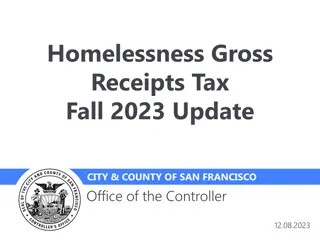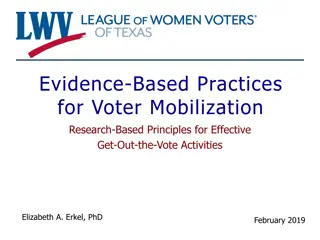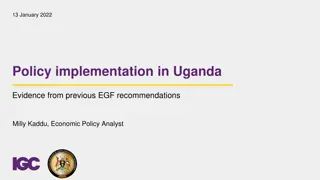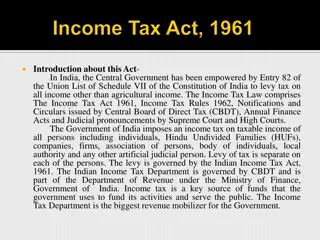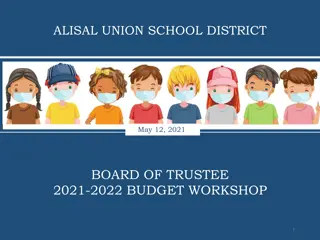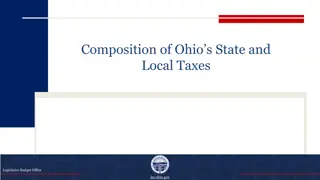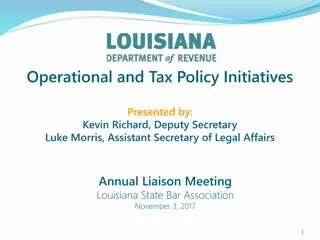Uganda's Tax Policy and Revenue Mobilization: Challenges and Measures
The Ministry of Finance, Planning, and Economic Development in Uganda faces challenges in revenue mobilization and implementing tax policy measures. The tax policy aims to generate revenue for budget financing, promote investment and exports, redistribute income, and ensure compliance with regional and international obligations. Uganda's tax structure includes taxes on income, such as Pay As You Earn (PAYE) and corporation tax, as well as Value Added Tax (VAT). The country applies VAT at a standard rate of 18% on goods and services.
Download Presentation

Please find below an Image/Link to download the presentation.
The content on the website is provided AS IS for your information and personal use only. It may not be sold, licensed, or shared on other websites without obtaining consent from the author.If you encounter any issues during the download, it is possible that the publisher has removed the file from their server.
You are allowed to download the files provided on this website for personal or commercial use, subject to the condition that they are used lawfully. All files are the property of their respective owners.
The content on the website is provided AS IS for your information and personal use only. It may not be sold, licensed, or shared on other websites without obtaining consent from the author.
E N D
Presentation Transcript
REVENUE MOBILIZATION, CHALLENGES AND TAX POLICY MEASURES MINISTRY OF FINANCE, PLANNING AND ECONOMIC DEVELOPMENT SEPTEMBER, 2018
OUTLINE Background Objectives of Uganda s Tax Policy Uganda s Tax Structure Revenue Performance for FY 2016/17 Domestic Revenue Mobilization Tax Amendments for FY 2018/19 Obligations by LGs Conclusion
BACKGROUND The mandate to tax is derived from Section 152 of the Constitution, No tax shall be imposed except with the authority of an act of Parliament Section 153 of the Constitution also provides that all such revenues shall be deposited in the consolidated fund Section 8 of the PFM Act 2015 provides that the Minister shall present to Parliament tax and revenue bills, which give government power to collect money from taxes, fees and other charges in pursuit of the fiscal objectives Tax policy design is derived from the wider development and fiscal policy objectives as stipulated in the National Development Plan II The policy is accordingly developed and enacted into various tax laws for implementation by Uganda Revenue Authority
OBJECTIVES OF TAX POLICY Generation of adequate revenue to finance the Budget Promotion of investment and exports Redistribution of Income Compliance to regional and international obligations Non-discrimination
THE TAX STRUCTURE TAXES ON INCOME Individual income Individual income includes employment income which is subjected to Pay As You Earn (PAYE) (at 30%), dividends and interest (subjected to WHT at rates ranging from 10% to 40%) per ITA, Cap 340 Business income This includes corporation tax (at a rate of 30%), rental income (20%), property taxes and other taxes provided for in the ITA, Cap 340 VALUE ADDED TAX (VAT) VAT is a broad based tax which is charged on the consumption of goods and services both locally produced and imported i. i.
TAX STRUCTURE.CONTD a. Uganda applies VAT at a standard rate of 18% on the supply of all goods and services. b. Although, we charge 0% VAT on exports and a few other supplies defined in the law. c. The VAT Act also provides for some exempt supplies as defined in the VAT Act, Cap 349 EXCISE DUTY i. Imposed under the Excise duty Act, 2014, with rates ranging from 5% to 100%. Excise is imposed on the manufacture, sale or use of certain types of goods and products such as beer, cigarettes, fuel, telecommunication services etc.
STRUCTURE.CONTD INTERNATIONAL TRADE TAXES i. International trade taxes (customs duties) are administered under the Protocol establishing the East African Community Customs Union (EACCU) ii. It s main futures are the East African Community Customs Management Act (EACCMA), the Common External Tariff (CET) and the Rules of Origin The CET comprises of four (4) main duty band on imports from outside the EAC region - 0% for raw materials; 10% for intermediate goods; and 25% for finished goods 35% and 100% for sensitive items (deemed critical for the livelihood of the people)
TAX STRUCTURECONTD NON TAX REVENUE (NTR) This is mainly fees, levies and other payments for Government services i.e. passport fees, penalties, court fees etc. It is important to note that Government s policy is to increase NTR collections and its contribution to the budget by raising NTR GDP ratio by 0.2 percentage points every year
REVENUE PERFORMANCE FY 2016/17 The objective of Government is to raise domestic revenues by 0.5 percentage points of Gross Domestic Product annually This is based on policy measures and improved tax administration, in addition to set macroeconomic assumptions. However, it should be noted that the assumptions are sometimes not achieved and this therefore affected the revenue performance. The table below illustrates the assumptions made for FY 2016/17. Table 1: Macroeconomic Assumptions provided for 2016/17 2015/16 Outturn 3,476.6 2016/17 Projection 3,474.8 Outturn 3,524.1 Exchange rate (UGX per US Dollar) Inflation (Headline) (%) Change in non-fuel imports value (US$) (%) Real GDP (MP) growth (%) Growth in Private Sector credit (%) 6.6 -7.6 4.7 14.7 5.5 9.1 5.0 16.6 5.7 7.1 3.9 15.3
2016/17 2017/18 Shares % share of tax revenue for 2017/18 PERFORMANCE Budget Estimate Budget Estimate In the FY 2017/18, net revenue of UGX 14,506.93 billion was collected posting a momentous growth of UGX 1,736.48 billion (13.65%) compared to the FY 2016/17. Outturn Outturn Overall Net Revenues 13,446.79 12,797.26 14,506.93 103.06% 15,063.87 Net URA tax revenue 12,939.26 12,463.19 14,076.08 100.00% 14,683.60 PAYE 1,940.95 2,114.99 2,396.11 17.02% 2,360.91 However, the collections were UGX 606.32 billion below the FY 2017/18 target of UGX 15,062.43 billion. Corporate Tax 961.29 764.27 884.80 6.29% 846.41 Withholding Tax 823.24 677.93 754.29 5.36% 860.21 Excise duty 866.85 819.78 953.91 6.78% 1,052.22 The month of June 2018, contributed 12.2% (UGX 1,763.91 billion) to the FY 2017/18 net revenue collections. Value Added Tax 1,952.44 2,022.19 2,234.81 15.88% 2,611.58 Taxes on International Trade 5,791.96 5,414.56 6,210.84 44.12% 6,183.82 Tax Refunds Motor Vehicle Fees (Traffic Act) (187.5) (175.32) (203.64) -1.45% (206.67) This was the highest monthly revenue contribution to the annual collections 177.52 80.34 98.19 0.70% 85.37 Drivers Permits 55 33.56 37.33 0.27% 64.62 Non-Tax Revenues 330.01 334.07 430.85 3.06% 380.26
RESOURCE ENVELOPE FY 2018/19 The resource envelope for FY 2018/19 amounts to Shs 32,702.8 billion detailed as follows:- i. Domestic revenue amounting to Shs 16,358.8 billion of which Shs 15,938.8 billion will be collected by URA as tax revenue and Shs 420 billion as non-tax revenue ii. Domestic borrowing amount to Shs 1,783.4 billion iii. Budget support amounting to Shs 289 billion iv. External financing for projects amounting to Shs.7,734.5 billion of which Shs. 6,148.9 billion is in loans, and Shs. 1,585.6 billion is grants v. Appropriation in Aid, collected by Government Departments amounting to Shs 1,063.5 billion; and vi. Domestic debt re-financing will amount to Shs 5,271.5 trillion
DOMESTIC REVENUE MOBILIZATION Government s main goal is to raise revenue to GDP ratio from current 14% to 16% by the FY 2019/20 as envisaged in the National Development Plan II (NDPII). However, the tax to GDP ratio remains low compared to the East African region and the Sub Saharan Africa average. Government is developing a Domestic Revenue Mobilization Strategy, which will inform reforms in tax system in the medium term and long term. Thus, the overall revenue target of Shs 16,358.8 billion for 2018/19, translates into a growth of 7.6% compared to the target of Shs 15,063 billion for FY 2017/18 and this translates to 14.7 as a percentage of GDP.
REVENUE MOBILIZATION .. CONTD The informal sector accounts for 43.1% of Uganda s total economy (source: UBOS) However, Government revenue collections is not yet at par with GDP growth rates. Our tax to GDP ratio is only 14%, and lowest in Sub-Saharan Africa (average: 17%) This disparity is due to a huge informal sector that continuously escapes regulations, taxation or observation. It is mostly hidden and the operations are unreported or unknown.
REVENUE MOBILIZATION .. CONTD In order to address the challenges to domestic revenue mobilization, the Ministry of Finance is in the final stages of developing a Domestic Revenue Mobilization Strategy (DRMS) A committee has been set up by the Ministry of Finance to fast track developing of the DRMS. This committee comprises of MoFPED, URA, the Civil Society and Development Partners It is envisaged that through this strategy, Government will be able to identify weaknesses in the tax system and untapped potential, followed by designing a comprehensive strategy to overcome these challenges and improve revenue collection
THE DRM STRATEGY Objectives of the DRM Strategy will include; Create clear and specific tax policies based on sound cost-benefit analysis and research; Improving the capacity of the revenue administration to collect revenue, in terms of staff numbers, training, and financing; Improve citizen perceptions of taxation and strengthen the ties between taxation and service delivery; Improve transparency and accountability with respect to revenue generation and expenditure; and Enhance stakeholder understanding and appreciation for the whole tax system.
TAX AMENDMENTS FOR FY 2018/19 Income Tax The Income Tax Act was amended as follows:- Introduction of an alternative minimum tax of 0.5% of annual gross income for companies that post losses for 7 consecutive years Introduction of 10% final withholding tax on commissions by telecommunication companies to mobile money & airtime agents as a final tax Reinstatement of corporation tax on SACCOs Amending the Income Tax Act to apply withholding tax on all winnings of Gaming, Sports and Pool betting payments Enforcement of withholding tax on persons engaged in agriculture at 1%
TAX AMENDMENTS .. CONTD Excise Duty Introduction of excise duty on opaque beer (kibuku) Imposition of excise duty on cooking oil (Shs. 200 per litre) Imposition of excise duty at 15% on all juices including powders for reconstruction like tang and dilute to taste drinks Increase in excise duty on diesel and petrol by Shs. 100 per litre Increase in excise duty on mobile money and bank charges from 10% to 15% Imposition of excise duty of UGX 200,000 on motorcycles at first registration Levy of 1% on Mobile Money (currently being reviewed by parliament) Daily levy of UShs. 200 on over The Top Services (OTT)
TAX AMENDMENTS .. CONTD Value Added Tax Exclusion of goods for private use from the scope of the application of the VAT deemed payment provisions Obligation for Government Ministries, Departments, Agencies and designated persons to withhold VAT on their purchases Non-tax Revenue Increase of motor vehicle first registration fees from Shs. 1,200,000 to Shs. 1,300,000 Expansion of the scope of environmental levy to include goods vehicles over 7 tonnes Review of the age limit of imported motor vehicles to 15 years
TAX ADMINISTRATION INITIATIVES Various initiatives have been instigated; including monitoring of different taxpayer segments, expanding of taxpayer s register, monitoring of filing ratios, audit and arrears, among others. These are aimed at encouraging voluntary taxpayer compliance and influencing taxpayer s behavior Tax administration has been enhanced through taxpayer education, strengthening detection of non-complaint taxpayers, recovery of tax arrears and combating smuggling, undervaluation and under declaration Automation of online assessments and the electronic tracking of transit goods from Mombasa are already on-going Customs data is being synchronized with domestic tax returns
OBLIGATIONS BY LGS Local Governments should comply with the tax laws (Sec 116, Sec 119 & 124 of ITA) and URA procedures with respect to remitting the applicable taxes. Once taxes are withheld, LGs should promptly remit them to URA in line with the legal requirements LGs are also reminded of the obligation to budget for taxes under work plans and procurement plans in a timely manner to affect revenue performance. Taxes should be budgeted for and remitted as follows:- Value Added Tax (VAT) should have first call on the resources and must be adequately budgeted for, except for items exempted under the VAT Act. PAYE withheld from employees must be remitted to URA promptly as stipulated under the law. Import duty must be paid on procurement of imports by LGs; and Withholding tax should be remitted as soon as withheld at source.
CONCLUSION The Ministry attaches great importance on the Local Government budget consultations, in view of enhancing domestic revenue mobilization. As key stakeholders, LGs are encouraged to support the Central Government in ensuring tax compliance as well as value for money in public expenditure management. Particularly, LGs should remit the necessary taxes on time to URA including; PAYE, VAT and withholding tax. The guidance in BECs and BCCs must also be complied with.


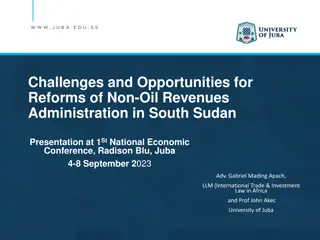
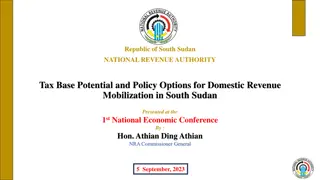
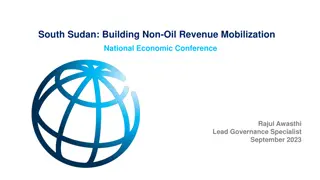
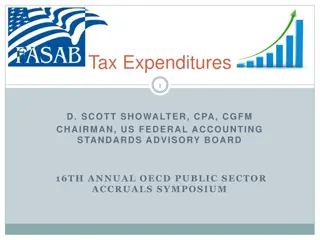
![Town of [Town Name] Real Estate Tax Rates and FY 2024 Budget Summary](/thumb/62211/town-of-town-name-real-estate-tax-rates-and-fy-2024-budget-summary.jpg)
